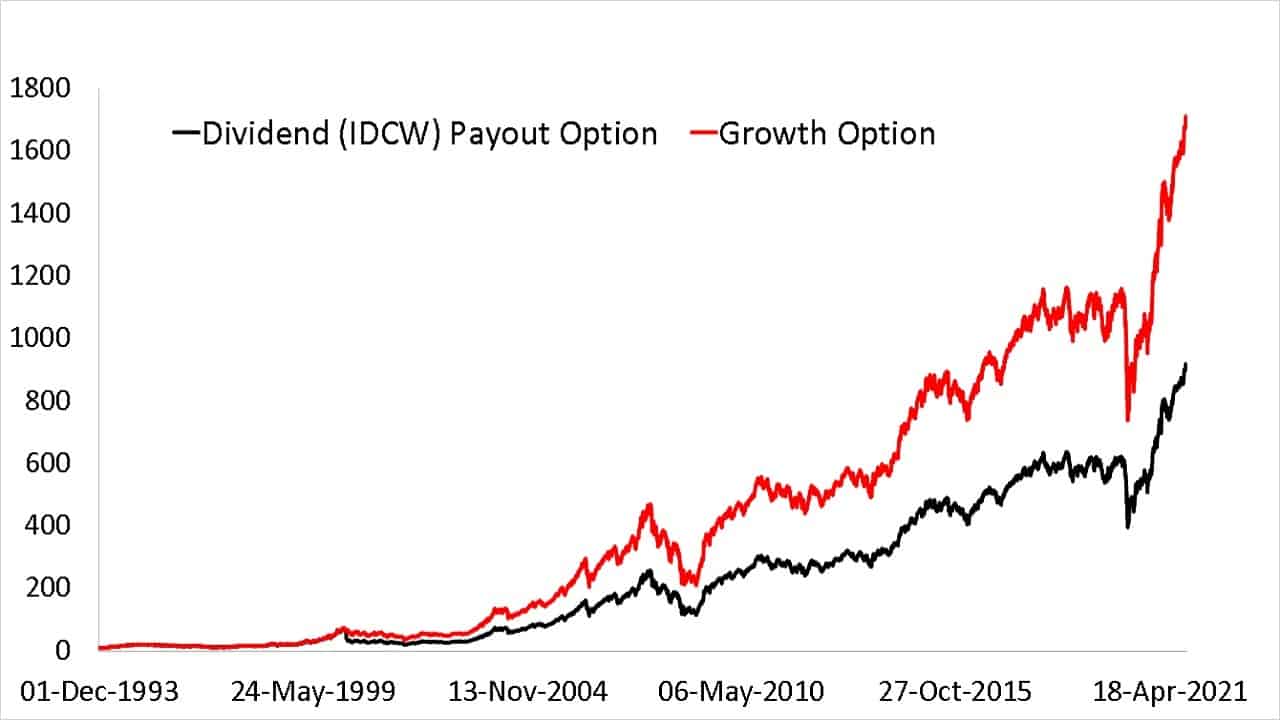Last Updated on December 29, 2021 at 6:24 pm
Anand has an interesting question, “Dear Pattu Sir, I was looking to invest in a mutual fund offering regular dividends* but I can only see the returns of the growth option listed everywhere. Can you please explain why dividend option returns are not published?”
* SEBI has mandated that mutual fund dividends be called “Income Distribution cum Capital Withdrawal (IDCW)”. Many investors assumed dividends were “extra” without appreciating that they are derived by selling stocks or bonds (capital withdrawal from the fund) and distributed as income to unitholders. For more information on how this works, see: When do mutual funds declare dividends. We shall continue to use the term dividends in this article as IDCW is quite grotesque.
Mutual fund dividend option returns are never published because if computed correctly, the dividend option return will always be the same (ideally) as the growth option. A practical calculation will result in slight return differences.
The NAV of a dividend option is always lower than that of the growth option./ For example, ICICI Bal Adv Fund Growth Option Regular Plan has a NAV of 48.31 (17th Sep 2021), while the ICICI Bal Adv Fund Monthly IDCW option Direct Plan has a NAV of 17.21 on the same date.
Join 32,000+ readers and get free money management solutions delivered to your inbox! Subscribe to get posts via email! (Link takes you to our email sign-up form)
🔥Want to create a complete financial plan? Learn goal-based investing? Exclusive access to our DIY tools? Increase your income with your skills? Use this link to enjoy massive discounts on our robo-advisory tool & courses! 🔥
This is because each time a dividend is declared, the net asset value (NAV) decreases by an amount equal to the dividend rate – (typically a few rupees per unit)
This lower NAV is known as Ex-dividend NAV
(Ex-dividend NAV + Div. Rate = Cum-Dividend NAV)
SEBI has mandated that dividends should be deemed as reinvested at ex-dividend NAV for calculating returns.
This means you cannot calculate XIRR this way: enter the investments amounts with a negative sign with dates; enter the dividends received with a positive sign (payout) with dates; enter the current value with a positive sign with the date; compute XIRR. You are guaranteed to get a different return from a corresponding investment in the growth option.
- Suppose a new fund was started on 1st Jan 2020. The NAV of all the options (growth and IDCW) will be Rs. 10 per unit.
- On March 1st, the NAV of the growth option was, say, Rs. 12 per unit. The dividend option (IDCW) NAV was Rs. 10 per unit. A dividend of Rs. 2 per unit was declared (we will assume on the same day for simplicity), and the IDCW option NAV fell from Rs. 12 per unit to Rs. 10 per unit.
- On Sept 1st, the growth option NAV was Rs. 15 per unit. The dividend option NAV was Rs. 12.5 per unit.
Over time the difference in NAV can be significant.

Let us compute XIRR the wrong way (or the easy way) first.
Growth option
| Date | Transaction |
| 01-01-2020 | -10 |
| 01-03-2020 | |
| 01-09-2021 | 15 |
| XIRR | 27.51% |
We will follow the convention that investments are designated as negative and redemptions or payouts as positive. The opposite can also be used. So 1 unit of the growth option for Rs. 10 was purchased on 1st Jan 2010, and its value as of 1st Sep 2021 is Rs. 15
Dividend (IDCW) Option
| Date | Transaction |
| 01-01-2020 | -10 |
| 01-03-2020 | 2 |
| 01-09-2021 | 12.5 |
| XIRR | 29.85% |
Here we used the lazy approach and assumed we had received Rs. 2 as a dividend payout. Notice that dividend option XIRR is more than 2% different from the growth option XIRR.
This is wrong because the growth option keeps all the money in the fund and does not distribute it. The growth option NAV has grown by 25% from March 2020 to Sep 2021, and so has the dividend option NAV. If the dividend was not declared, both options would result in the same return.
There is no way to compare the two returns unless the dividends are assumed to be reinvested back into the fund. Please note: It does not matter what the investor does with the dividend payout. Whether they reinvest into the same fund or not, the dividends will have to be assumed as reinvested for dividend option return calculation.
XIRR usage is a classic example of garbage in, garbage out. Just because the XIRR solver provides a return does not mean it is correct. The inputs have to make sense first.
If we don’t do this, the investment return will be wrong. So for this simple example:
The right way to compute XIRR from dividends
| Date | Transaction |
| 01-01-2020 | -10 |
| 01-03-2020 | 2 |
| 01-03-2020 | -2 |
| 01-09-2021 | 15 |
| XIRR | 27.51% |
Here the Rs. 2 received as dividend is reinvested back into the fund. Then the XIRRs of growth and IDCW options match.
The real-world calculation with multiple dividends is quite cumbersome. See: How to calculate returns from Dividend Mutual Funds?
Many stock investors and stock analysis portals make the mistake of treating dividends as payouts. This means they can never benchmark their stock returns with a fixed-income instrument or equity index. They will get “some” return number that does not reflect the risk premium in the investment. Meaning it is useless. That most investors don’t want to (or are too scared to) benchmark their investments is another matter!
If you want to do it right (compute XIRR with reinvested dividends), you can try these. Stocks: Compute XIRR (annualised return) of stocks and stock portfolio with this sheet! Mutual funds: Automated Mutual Fund Performance Tracker.
In summary, a dividend option or IDCW option mutual fund will always have the same return as the growth option when dividends are assumed to be reinvested (this is the universal convention for both mutual funds and stocks). Therfore mutual fund dividend option returns are not explicitly published as there is no need for this.

Use our Robo-advisory Tool to create a complete financial plan! ⇐More than 3,000 investors and advisors use this! Use the discount code: robo25 for a 20% discount. Plan your retirement (early, normal, before, and after), as well as non-recurring financial goals (such as child education) and recurring financial goals (like holidays and appliance purchases). The tool would help anyone aged 18 to 80 plan for their retirement, as well as six other non-recurring financial goals and four recurring financial goals, with a detailed cash flow summary.
🔥You can also avail massive discounts on our courses and the freefincal investor circle! 🔥& join our community of 8000+ users!
Track your mutual funds and stock investments with this Google Sheet!
We also publish monthly equity mutual funds, debt and hybrid mutual funds, index funds, and ETF screeners, as well as momentum and low-volatility stock screeners.
You can follow our articles on Google News

We have over 1,000 videos on YouTube!

Join our WhatsApp Channel



- Do you have a comment about the above article? Reach out to us on Twitter: @freefincal or @pattufreefincal
- Have a question? Subscribe to our newsletter using the form below.
- Hit 'reply' to any email from us! We do not offer personalised investment advice. We can write a detailed article without mentioning your name if you have a generic question.
Join 32,000+ readers and get free money management solutions delivered to your inbox! Subscribe to get posts via email! (Link takes you to our email sign-up form)
About The Author
 Dr M. Pattabiraman (PhD) is the founder, managing editor and primary author of freefincal. He is an associate professor at the Indian Institute of Technology, Madras. He has over 13 years of experience publishing news analysis, research and financial product development. Connect with him via Twitter(X), LinkedIn, or YouTube. Pattabiraman has co-authored three print books: (1) You can be rich too with goal-based investing (CNBC TV18) for DIY investors. (2) Gamechanger for young earners. (3) Chinchu Gets a Superpower! for kids. He has also written seven other free e-books on various money management topics. He is a patron and co-founder of “Fee-only India,” an organisation promoting unbiased, commission-free, AUM-independent investment advice.
Dr M. Pattabiraman (PhD) is the founder, managing editor and primary author of freefincal. He is an associate professor at the Indian Institute of Technology, Madras. He has over 13 years of experience publishing news analysis, research and financial product development. Connect with him via Twitter(X), LinkedIn, or YouTube. Pattabiraman has co-authored three print books: (1) You can be rich too with goal-based investing (CNBC TV18) for DIY investors. (2) Gamechanger for young earners. (3) Chinchu Gets a Superpower! for kids. He has also written seven other free e-books on various money management topics. He is a patron and co-founder of “Fee-only India,” an organisation promoting unbiased, commission-free, AUM-independent investment advice.Our flagship course! Learn to manage your portfolio like a pro to achieve your goals regardless of market conditions! ⇐ More than 3,500 investors and advisors are part of our exclusive community! Get clarity on how to plan for your goals and achieve the necessary corpus no matter the market condition!! Watch the first lecture for free! One-time payment! No recurring fees! Life-long access to videos! Reduce fear, uncertainty and doubt while investing! Learn how to plan for your goals before and after retirement with confidence.
Increase your income by getting people to pay for your skills! ⇐ More than 800 salaried employees, entrepreneurs and financial advisors are part of our exclusive community! Learn how to get people to pay for your skills! Whether you are a professional or small business owner seeking more clients through online visibility, or a salaried individual looking for a side income or passive income, we will show you how to achieve this by showcasing your skills and building a community that trusts and pays you. (watch 1st lecture for free). One-time payment! No recurring fees! Life-long access to videos!
Our book for kids: “Chinchu Gets a Superpower!” is now available!


Must-read book even for adults! This is something that every parent should teach their kids right from their young age. The importance of money management and decision making based on their wants and needs. Very nicely written in simple terms. - Arun.Buy the book: Chinchu gets a superpower for your child!
How to profit from content writing: Our new ebook is for those interested in getting a side income via content writing. It is available at a 50% discount for Rs. 500 only!
Do you want to check if the market is overvalued or undervalued? Use our market valuation tool (it will work with any index!), or get the Tactical Buy/Sell timing tool!
We publish monthly mutual fund screeners and momentum, low-volatility stock screeners.
About freefincal & its content policy. Freefincal is a News Media organisation dedicated to providing original analysis, reports, reviews and insights on mutual funds, stocks, investing, retirement and personal finance developments. We do so without conflict of interest and bias. Follow us on Google News. Freefincal serves more than three million readers a year (5 million page views) with articles based only on factual information and detailed analysis by its authors. All statements made will be verified with credible and knowledgeable sources before publication. Freefincal does not publish paid articles, promotions, PR, satire or opinions without data. All opinions will be inferences backed by verifiable, reproducible evidence/data. Contact Information: To get in touch, please use our contact form. (Sponsored posts or paid collaborations will not be entertained.)
Connect with us on social media
- Twitter @freefincal
- Subscribe to our YouTube Videos
- Posts feed via Feedburner.
Our publications
You Can Be Rich Too with Goal-Based Investing
 Published by CNBC TV18, this book is designed to help you ask the right questions and find the correct answers. Additionally, it comes with nine online calculators, allowing you to create custom solutions tailored to your lifestyle. Get it now.
Published by CNBC TV18, this book is designed to help you ask the right questions and find the correct answers. Additionally, it comes with nine online calculators, allowing you to create custom solutions tailored to your lifestyle. Get it now.Gamechanger: Forget Startups, Join Corporate & Still Live the Rich Life You Want
 This book is designed for young earners to get their basics right from the start! It will also help you travel to exotic places at a low cost! Get it or gift it to a young earner.
This book is designed for young earners to get their basics right from the start! It will also help you travel to exotic places at a low cost! Get it or gift it to a young earner.Your Ultimate Guide to Travel
 This is an in-depth exploration of vacation planning, including finding affordable flights, budget accommodations, and practical travel tips. It also examines the benefits of travelling slowly, both financially and psychologically, with links to relevant web pages and guidance at every step. Get the PDF for Rs 300 (instant download)
This is an in-depth exploration of vacation planning, including finding affordable flights, budget accommodations, and practical travel tips. It also examines the benefits of travelling slowly, both financially and psychologically, with links to relevant web pages and guidance at every step. Get the PDF for Rs 300 (instant download)